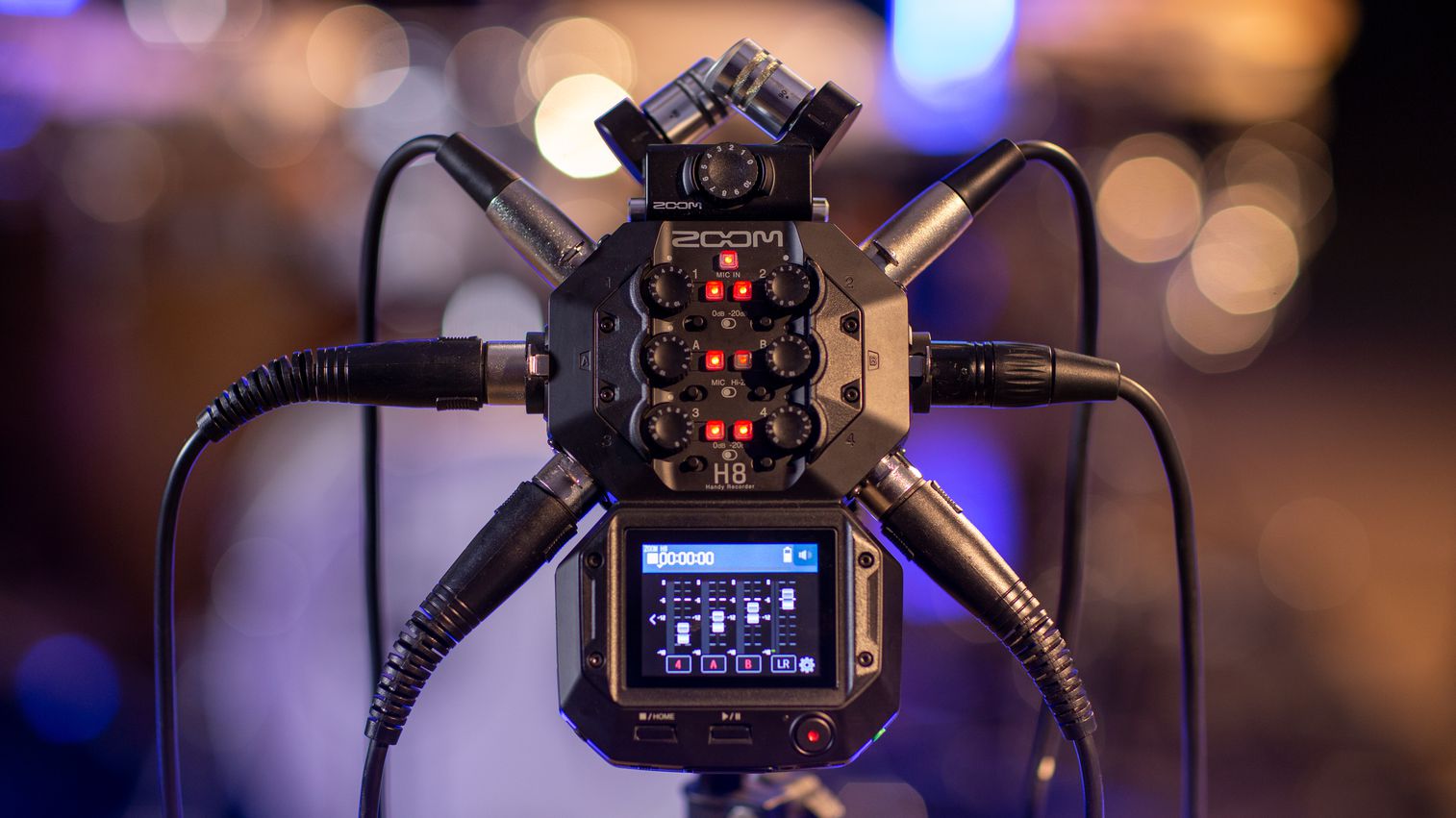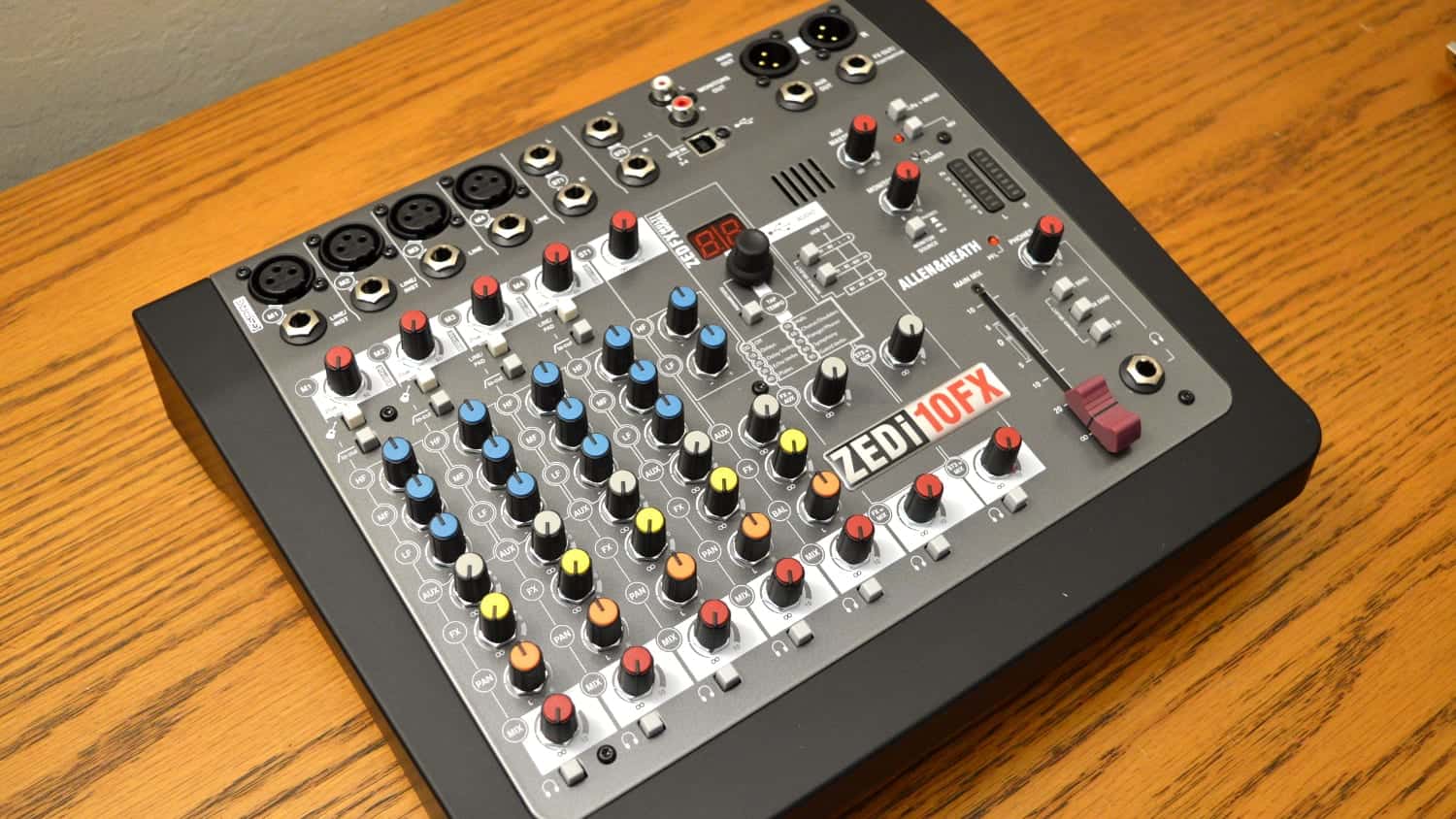Over the past decade, I’ve witnessed portable podcast recorders transform from basic stereo gadgets into powerful, studio-quality tools. In this guide, we’ll skip the fluff and dive into the best portable podcast recorders that can take your podcast production to the next level.
Additionally, in 2025 and beyond, the podcasting world is experiencing remarkable innovations, with portable recorders becoming more versatile, feature-rich, and user-friendly than ever.
Join me as we explore the top 10 best portable podcast recorders that can help you capture high-quality audio wherever your creativity takes you.
1. Zoom H8
Best Overall Choice

Key Features:
- 12 XLR/TRS inputs
- 32-bit float recording
- 20-hour battery life
- Advanced smartphone integration
- Wireless timecode sync
Real-World Performance: The H8 Pro shines in multi-speaker situations. Last month, I recorded a 6-person roundtable discussion, and the preamps handled everything beautifully. The smartphone integration meant I could monitor levels from across the room without hovering over my guests.
Compared to Competition:
- Better battery life than Sound Devices MixPre-6 II
- More inputs than Tascam DR-44WLX
- More affordable than premium options
- Slightly bulkier than smaller units
Perfect For: Professional podcasters who need maximum flexibility and reliability.
2. Sound Devices MixPre-6 II
Premium Choice

Key Features:
- Kashmir premium preamps
- 32-bit float recording
- Carbon fiber construction
- Professional timecode
- USB audio interface capability
Real-World Experience: The preamp quality is unmatched. Recording orchestral performances or whispered interviews, the noise floor is practically non-existent. However, the premium price point might be overkill for basic podcast needs.
Versus Zoom H8 Pro:
- Superior preamp quality
- Better build quality
- Higher price point
- Fewer inputs
- Shorter battery life
Perfect For: Audio professionals who need the absolute best sound quality.
3. Tascam DR-44WLX
Best Budget Option

Key Features:
- Quad-channel recording
- Built-in WiFi
- 128GB storage support
- 12-hour battery life
- Improved preamps
Practical Experience: Don’t let the lower price fool you. I’ve used this for countless interviews, and the preamps are surprisingly quiet. The WiFi feature saves time when transferring files.
Compared to Higher-End Models:
- Better value than premium options
- Fewer features than H8 Pro
- Simpler interface than MixPre-6 II
- More robust than Rode PodMic Go
Perfect For: Beginning podcasters who need professional features without breaking the bank.
4. Zoom PodTrak P4
Best for Beginners

Key Features:
- 🎙️ 4 XLR inputs – Perfect for solo or multi-guest podcasts.
🎚️ Individual gain controls – Adjust each mic easily.
🔊 Sound pads – Add effects or intro music on the fly.
📲 Remote guest support – Connect phone calls or VoIP services.
🔋 Battery or USB-powered – Record anywhere, anytime.
Usage Insights: Ideal for solo podcasters or simple interviews. The built-in processing helps achieve professional sound without a complex setup.
Comparison:
- Simpler than other options
- More limited than multi-input recorders
- Better smartphone integration
- More affordable entry point
Perfect For: Solo podcasters and beginners.
5. Tascam Portacapture X6
Best for Music and Podcasting

Why It’s Great for Music & Podcasting:
- 📲 Touchscreen interface – Intuitive 2.4″ color touchscreen for easy navigation.
- 🎤 6-track recording – Perfect for multi-mic podcasts or layered music sessions.
- 🔄 Customizable presets – Podcast, music, ASMR, and field recording modes.
- 🎚️ High-quality preamps – Delivers crisp, clean audio without background hiss.
- 🔋 Battery, USB, or external power – Record anywhere, anytime.
Music-friendly features: Adjustable mic angles and dual condenser mics make it perfect for capturing instruments and vocals.
Versus Others:
- Better mixing capabilities than Zoom H8
- More expensive than budget options
- Superior effects processing
- Steeper learning curve
Perfect For: Podcasters who also record music or need advanced mixing features.
6. Marantz Professional PMD-901V
Best for Video Integration

Key Features:
- Video sync capability
- 4 XLR inputs
- 32-bit float recording
- HDMI monitoring
- 10-hour battery life
Standout Features: Perfect for video podcasters. The HDMI monitoring and timecode features make audio-video sync issues a thing of the past. Cops can also use this!
Comparison:
- Better video integration than others
- Fewer audio inputs than Zoom H8
- More specialized than general recorders
- Higher price point than basic options
Perfect For: Video podcasters and content creators who need perfect audio-video sync.
7. Sony PCM-D10 Pro
Best Portability

Key Features:
- Ultra-compact design
- High-res recording
- 15-hour battery life
- Built-in stereo mics
- USB-C interface
Real-World Use: The perfect backup recorder or travel companion. I’ve recorded entire episodes using just the built-in mics with impressive results.
Versus Larger Units:
- More portable than others
- Fewer inputs than larger recorders
- Better built-in mics
- More affordable than premium options
Perfect For: Mobile podcasters and journalists who need ultimate portability.
8. RØDECaster Pro II
Best Studio Integration

Why the RØDECaster Pro II Works for Both Field & Studio:
- 🎚️ Quad-core audio engine – Delivers studio-grade performance.
- 🎤 Revolution Preamps – Ultra-low noise and high gain for professional sound.
- 🔌 USB-C Dual Interface – Connects to two computers simultaneously for flexible studio setups.
- 🎛️ Multitrack recording – Capture individual tracks to a microSD card or directly to your DAW.
- 🌐 Wi-Fi & Ethernet connectivity – Remote firmware updates and wireless control.
Bonus: It has customizable sound pads and built-in effects, and supports Bluetooth audio—perfect for both podcasts and music sessions.
Comparison:
- Better studio integration than others
- Fewer field-specific features
- Better software integration
Perfect For: Podcasters who need seamless studio-to-field workflow.
9. Allen & Heath ZED-10FX
Best Value Mid-Range

Why It’s a Great Alternative:
- 🎚️ 4 XLR mic/line inputs – Perfect for small bands, podcasts, or field recordings.
- 🎛️ Built-in FX – Reverb, delay, and other effects for creative sound shaping.
- 🔌 USB audio interface – Plug-and-play with your DAW for studio integration.
- 🎤 High-quality preamps – Clean, noise-free recordings with plenty of headroom.
- ⚙️ Flexible I/O options – Balanced/unbalanced outputs, plus Hi-Z inputs for instruments.
Bonus: It’s rugged, reliable, and equally suited for live sound, podcasting, and music production.
Versus Others:
- Better build than budget options
- Fewer features than premium models
- More affordable than high-end units
- Simpler operation than complex recorders
Perfect For: Growing podcasters who need reliability without complexity.
10. StudioLive AR8c
Best for Professional Integration

Why It’s Ideal for Professional Use:
- 🔌 USB-C 24-bit/96kHz interface – Seamlessly integrates with professional DAWs.
- 🎤 High-headroom XMAX preamps – Crystal-clear sound for studio-grade recordings.
- 🎚️ 8-channel hybrid mixer – Perfect for podcasts, music production, and live performances.
- 🖥️ Multitrack recording – Record all channels individually to your DAW or SD card.
- 🎛️ Analog feel with digital flexibility – Hands-on control with digital convenience.
Bonus: It comes with Studio One Artist software and Capture for streamlined recording workflows.
Professional Applications: Perfect for professional broadcast integration. Expensive but worth it for those who need seamless professional workflow integration.
Comparison:
- Most professional features
- Better wireless integration
- Steeper learning curve
Perfect For: Professional broadcasters and high-end production companies.
Note: Prices of these gadgets are subject to change.
Advanced Features Worth Noting
Modern Connectivity
- Bluetooth monitoring
- WiFi file transfer
- Smartphone app control
- Cloud backup options
- USB-C fast charging
Free 5 Best VPNs for Content Creators in 2025
Safety Features
- Dual recording paths
- Backup recording tracks
- Auto-save functionality
- Power loss protection
- Recovery mode
Free 5 Best VPNs for Content Creators in 2025
Price-to-Feature Ratio 💰
Budget Tier ($100-250)
- Basic XLR inputs
- Decent preamps
- Standard battery life
- Basic file management
Free 5 Best VPNs for Content Creators in 2025
Mid-Tier ($250-500)
- Multiple XLR inputs
- Better preamps
- Advanced features
- Longer battery life
Discover 10 Best Gaming Monitors in 2025: An Expert Gamer’s Guide
Professional Tier ($500+)
- Premium preamps
- 32-bit float recording
- Timecode support
- Professional I/O
Learn How to Fix Audio Sync Issues in Podcasts: Sound Engineer’s Guide
Accessories to Consider 🎒
Essential Add-ons:
- Windscreens
- Shock mounts
- Power banks
- SD cards
- Carrying cases
Learn How to Fix Audio Sync Issues in Podcasts: Sound Engineer’s Guide
Conclusion
The perfect portable recorder depends on your specific needs, but the Zoom H8 Pro stands out as the best all-rounder for 2025 and beyond.
It strikes an excellent balance between professional features and usability, making it suitable for both beginners and pros.
FAQs
1. What is a portable podcast recorder?
A portable podcast recorder is a compact, lightweight device designed for recording high-quality audio on the go. It’s ideal for podcasters who need flexibility, whether recording in a studio, outdoors, or during interviews.
2. Why should I use a portable recorder instead of a smartphone?
While smartphones are convenient, portable recorders offer superior audio quality, advanced features like multi-track recording, and better noise reduction. They’re built specifically for professional-grade audio capture.
3. What features should I look for in a portable podcast recorder?
- Audio Quality: Look for high bit rates and sampling rates (e.g., 24-bit/96kHz).
- Multi-Track Recording: Allows separate recording for each microphone.
- Portability: Lightweight and compact for easy travel.
- Battery Life: Long-lasting power for extended sessions.
- Storage Options: Support for SD cards or internal memory.
- Connectivity: XLR inputs, USB ports, and Bluetooth for versatility.
4. What are the best brands for portable podcast recorders?
Top brands include:
- Zoom: Known for models like the Zoom H8 and H4n Pro, offering excellent sound and flexibility.
- Tascam: Popular for user-friendly devices like the Tascam DR-44WLX.
- Rode: Offers the Rodecaster Pro for podcast-specific features.
- Sony: Known for compact, high-quality audio devices.
5. Do portable recorders support external microphones?
Yes, most portable podcast recorders have inputs for external microphones, such as XLR or 3.5mm jacks. This allows you to use higher-quality microphones for professional audio.
6. Can I record multiple guests with a portable recorder?
Yes! Look for recorders with multiple inputs (e.g., Zoom H8 or Tascam DR-44WLX). These models support multiple microphones, making them perfect for interviews and group discussions.
7. How much do portable podcast recorders cost?
Prices vary based on features:
- Entry-level models: $100–$200 (e.g., Zoom H1n).
- Mid-range models: $200–$400 (e.g., Tascam DR-44WLX).
- Professional-grade models: $400+ (e.g., Zoom H8 or Rodecaster Pro).
8. How do I choose the right portable recorder for my needs?
- For beginners: Choose a simple, affordable option like the Rode PodMic Go.
- For mobile podcasters: Look for compact models with good battery life.
- For professionals: Opt for multi-track devices with XLR inputs like the Zoom H8 Pro.
- For group recordings: Ensure the device supports multiple microphones.
9. Can I edit my recordings directly on a portable recorder?
Some recorders include basic editing features, but for more advanced editing, transfer the audio to software like Audacity, GarageBand, or Adobe Audition.
10. How do I maintain my portable podcast recorder?
- Keep it clean: Use a soft cloth to wipe down the device.
- Protect it: Store it in a case to prevent dust and damage.
- Update firmware: Check for updates from the manufacturer.
- Use quality accessories: Invest in durable cables and SD cards.
11. What accessories improve portable podcast recording?
- External Microphones: For better sound quality.
- Pop Filters: Reduce plosive sounds.
- Windscreens: Minimize wind noise during outdoor recordings.
- Tripods or Mounts: Keep the recorder stable during use.
- Extra Batteries: Ensure uninterrupted recording sessions.
12. Are portable recorders suitable for video podcasting?
Yes, portable recorders can capture high-quality audio for video podcasts. Many models also offer features like line-out ports to sync audio with cameras.
Remember: Always test your recorder in similar conditions to your intended use before any critical recording session!
Discover 10 Best Gaming Monitors in 2025: An Expert Gamer’s Guide








